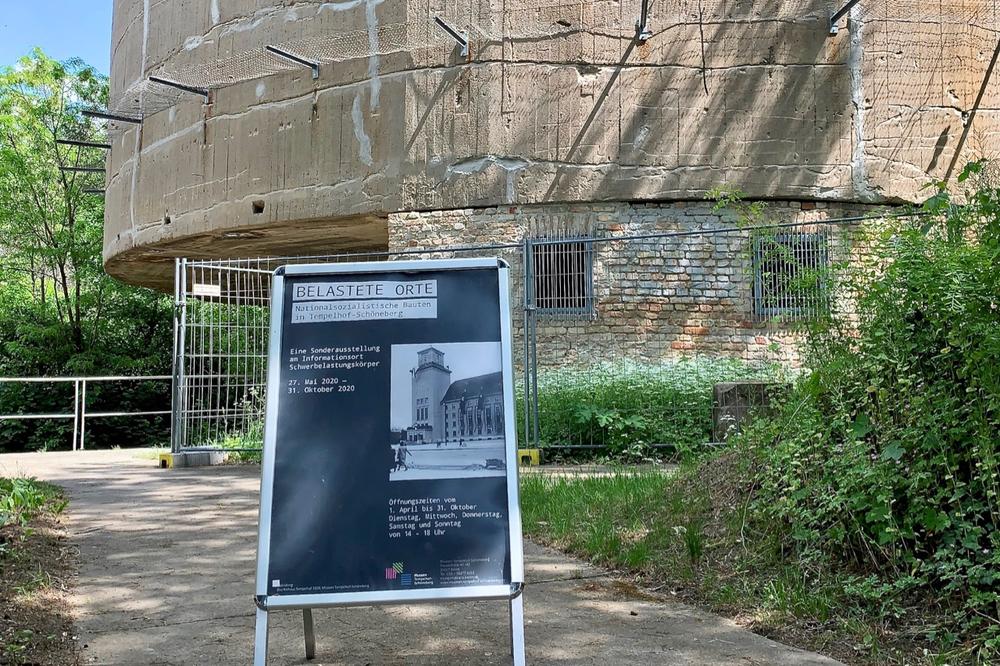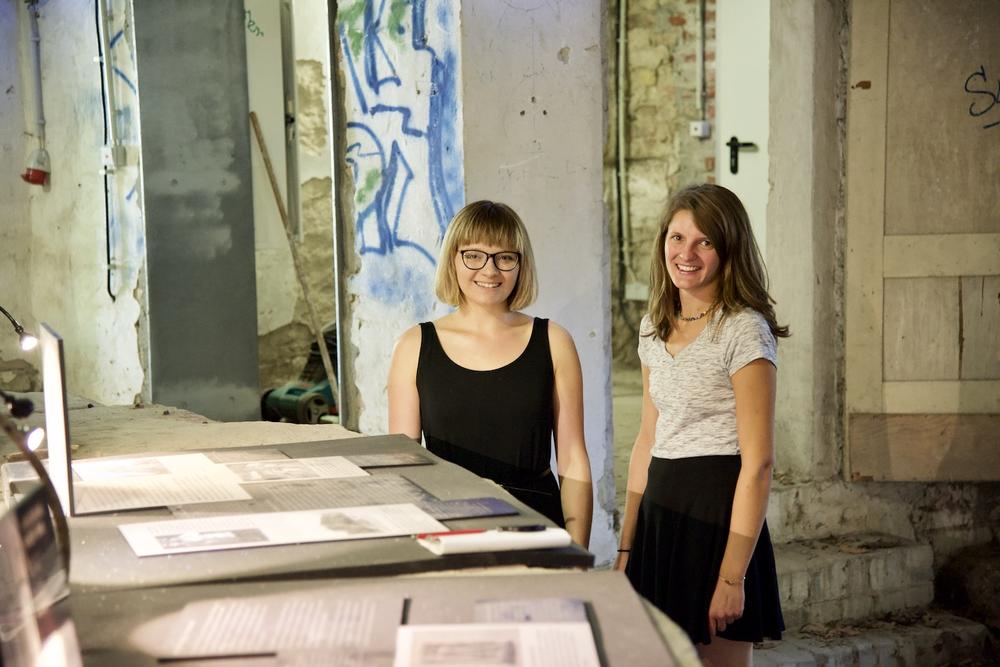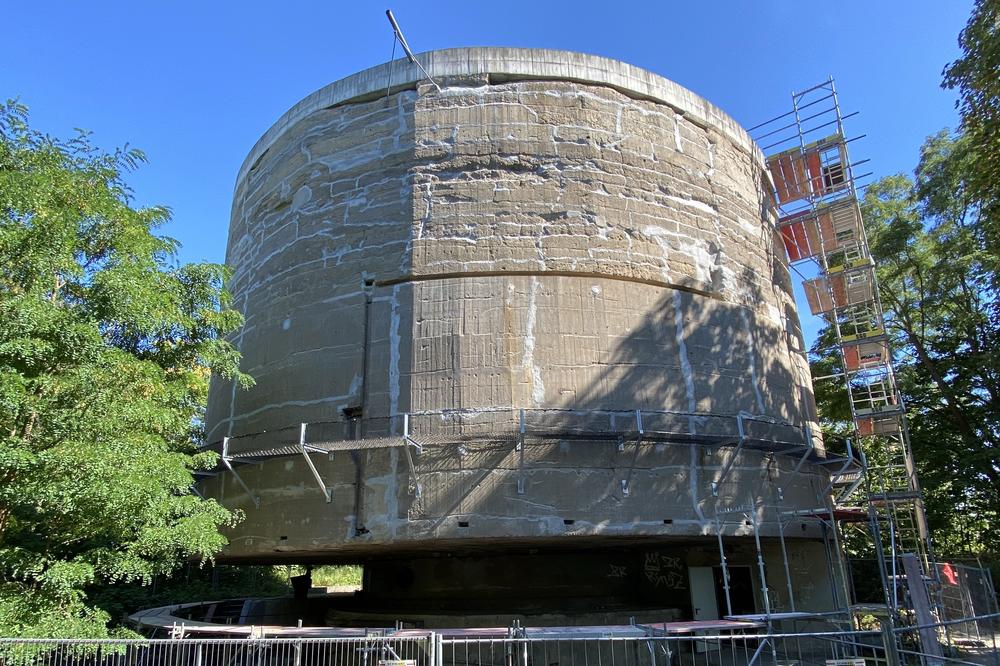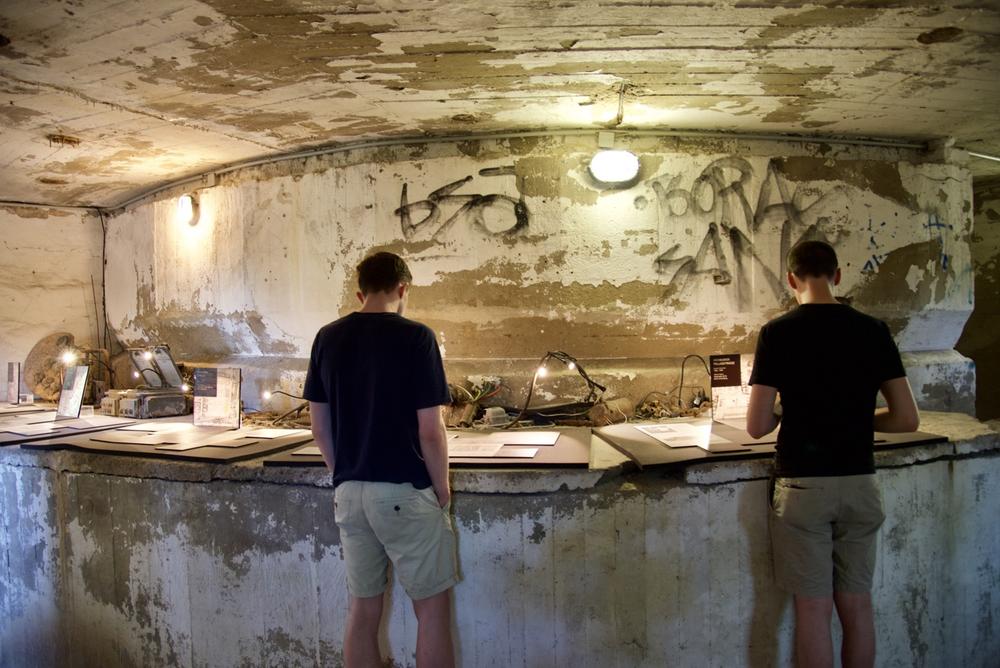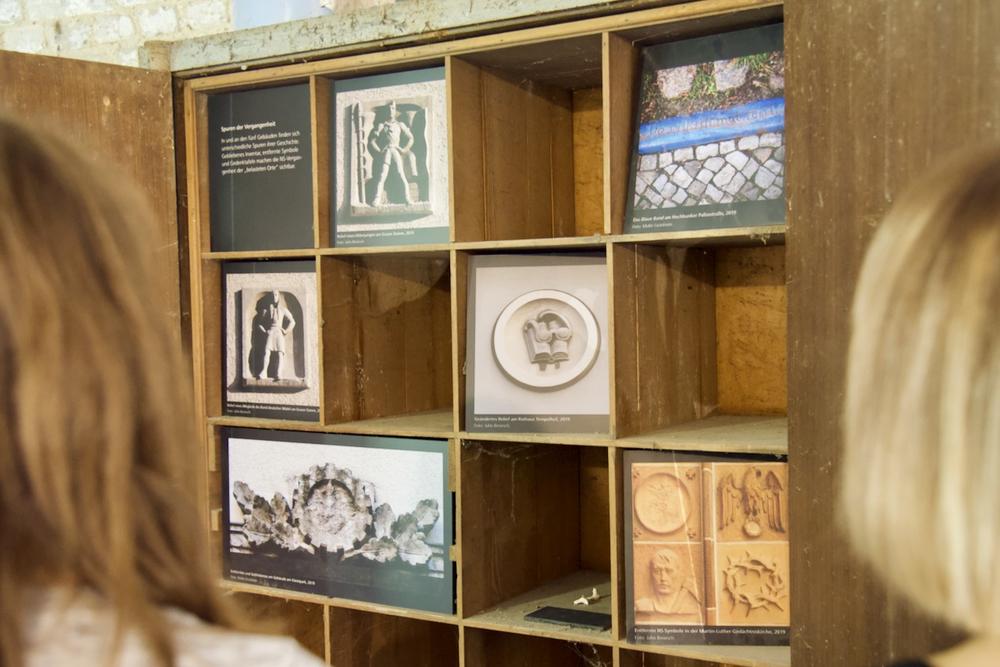Pragmatic Continued Use of “Burdened Places”
On display until the end of October: Students at Freie Universität Berlin designed a special exhibition at the Information Center Heavy Load-bearing Body with a focus on selected buildings of Nazi-era architecture
Sep 11, 2020
The exhibition will be on display in the Information Center Heavy Load-bearing Body until October 31.
Image Credit: Patric Sperlich / Museen Tempelhof-Schöneberg
Public history students Karolína Bukovská (at left) and Luise Fakler inside the test tower.
Image Credit: Sören Maahs
Surprisingly many architectural traces from the time of National Socialism have been preserved in Berlin. Spacious monumental buildings such as Tempelhof Airport, the Olympic Stadium, or the Reich Aviation Ministry are an integral part of the cityscape. Far less known than these former flagship buildings are Nazi buildings such as the heavy load-bearing body near the Südkreuz train station: a gigantic concrete cylinder that seems to have no function. Erected in 1941 with the help of forced laborers, the twelve thousand ton load body was supposed to test whether the Berlin soil in this location would support a 120-meter high triumphal arch for the planned “world capital Germania.”
Students in the master’s degree program in Public History at Freie Universität used this historically tainted building for their exhibition “Burdened Places.” A heavy iron door leads into the low measuring chamber of the concrete colossus. In the arched room, spread out on a semicircular concrete parapet, there are short texts on five buildings from the Nazi era in the Tempelhof-Schöneberg district. Construction plans as well as contemporary and current photos illustrate the concise construction descriptions.
Public History Project
The exhibition is arranged chronologically according to the year of construction, so that a kind of timeline can be traced. The selected buildings represent the creative diversity of National Socialist architecture, which has been wrongly reduced to the scaleless plans for the “world capital Germania.” According to Luise Fakler, “Albert Speer’s capital city planning attracts a great deal of attention. Hardly any of these plans were implemented. We wanted to focus on what actually came about and has been preserved to this day.” Luise Fakler is one of the 13 students at Freie Universität who developed the exhibition in a practical seminar in the master’s degree program in Public History.
Everything was in the hands of the students, from the conception to the design of the exhibition. “The nice thing about the degree program is the many practical and project-related events,” says public history student Karolína Bukovská, who is also involved in the exhibition. Together, the students researched the building files archives, looked for image material, cleared the image rights, and wrote the texts. They were supported by staff members of the Tempelhof-Schöneberg Museums. “Working with the students was a great opportunity for us to take a fresh look at the topic,” says Philipp Holt, exhibition curator and deputy director of the Tempelhof-Schöneberg Museums, who oversaw the project together with colleagues.
14 meters high, 18 meters deep in the ground, 21 meters in diameter. The heavy load-bearing body has been sinking slowly into the sandy soil for 80 years.
Image Credit: Sören Maahs
The exhibition features five buildings that are visible in the Berlin district of Tempelhof-Schöneberg, providing explanations that are lacking at the buildings.
Image Credit: Sören Maahs
Difficult Legacy, Continued Use
Dealing with the urban legacy of National Socialism is characterized by pragmatic continued use, which the exhibition makes very clear. “Most of the time, people were content with knocking off the stone swastikas and portraits of Hitler,” says Karolína Bukovská. Imperial eagles and other Nazi symbols were sometimes left alone. The buildings presented in the exhibition are still in use today. Some of them have different functions.
he administration building for the construction management of the Reichsautobahnen on Potsdamer Straße, completed in 1939, was used by the BVG public transportation company as its headquarters for more than 50 years after 1945. The Tempelhof City Hall, inaugurated in 1938, currrently houses various official offices of the district. “It is apparent from the floor plans that the City Hall was built during the National Socialist rule. There was no room suitable for a democratically elected district assembly. One was finally added in 1969,” explains Karolína Bukovská.
The Martin Luther Memorial Lutheran Church in Mariendorf was built in 1935. A man wearing an SA uniform is depicted on the baptismal font, and a soldier with a steel helmet is listening to Jesus’s Sermon on the Mount from the wood-carved pulpit. The housing complex on Grazer Damm, built in 1938, would also pass as social housing from the 1950s – if it were not for the relief with Hitler Youth above an entrance to the building.
An Architectural Oddity
Perhaps the most striking of the buildings presented is the former air raid shelter on Pallasstrasse. Despite the 13-story Pallasseum, the “Social Palace” erected on stilts above the bunker in 1978, the 20-meter-high bunker still stands out. Luise Fakler, who grew up in Schöneberg, remembers how even as a child, she perceived the large gray concrete block as an oppressive foreign body. She said, “I have always related the bunker to my life. Supposedly, I once asked my mother, if we had to go in there, if war broke out.”
Remaining ornaments and traces of symbols that were later removed are visible reminders of the building’s National Socialist past.
Image Credit: Sören Maahs
Construction of the bunker began in 1943. It was built for the Schöneberg Telecommunications Office by Soviet forced laborers who were interned with their families in the Augusta School next to the construction site. After the war ended, the school was renamed after the German resistance fighter Sophie Scholl. “One of the children of the forced laborers was Maria Derewjanko, from present-day Ukraine,” says Luise Fakler.
In the early 1990s, Derewjanko wrote a letter to the Sophie Scholl School. This led to a friendly exchange between members of the school and people in Ukraine, including mutual visits. “Stories like this of unexpected friendships are what made the research for the exhibition so vivid,” points out Luise Fakler. Maria Derewjanko can be seen in the exhibition in a photo of her taken in 1945 that shows her as a young girl, disguised in a costume from the Augusta School’s theater props.
Can Stone and Concrete Be “Bad” in and of Themselves?
The exhibition in the Heavy Load-Bearing Body refrains from offering political evaluations, without concealing the problems involved in dealing with this difficult legacy. How difficult it is to deal appropriately with the past is made apparent through the controversies surrounding the preservation of buildings erected between 1933 and 1945. Should buildings from the Nazi era be restored as historical monuments? Would that be tantamount to rehabilitation?
“That is a difficult question, and I do not have a general answer,” says Karolína Bukovská. “But I have to think, for example, of the people who are living in the buildings on Grazer Damm. We owe it to them to look after the buildings, just like other residential buildings.” At the same time, however, it is important not to retrospectively glorify National Socialist tyranny by highlighting its architectural evidence, and certainly not to deny the ideological intentions conveyed by this style of architecture.
The original German version of this article was published on September 9, 2020, in campus.leben, the online magazine of Freie Universität Berlin
Further Information
- The special exhibition “Burdened Places” will be on display in the Information Center Heavy Load-Bearing Body on General-Papestraße (at the corner of Loewenhardtdamm), 12101 Berlin (in Berlin-Tempelhof) until October 31. It is opened Tuesdays through Thursdays, as well as Saturdays and Sundays from 1 to 6 p.m. Admission is free.
- Dates for guided tours with public history students may be scheduled on the website of the Tempelhof-Schöneberg Museums. (to be announced soon)

